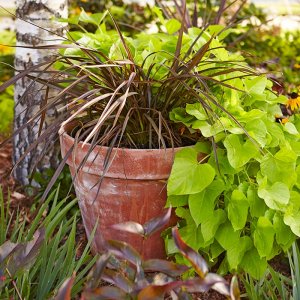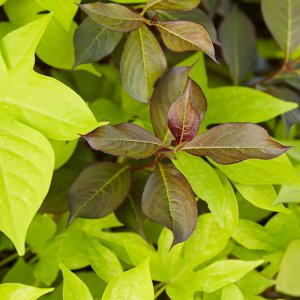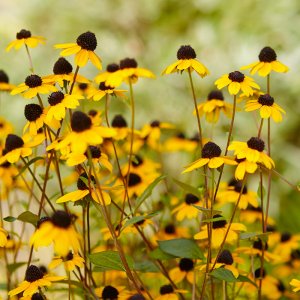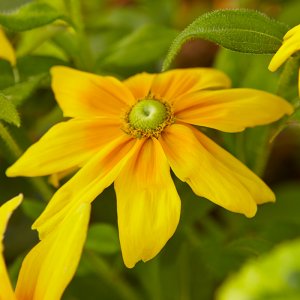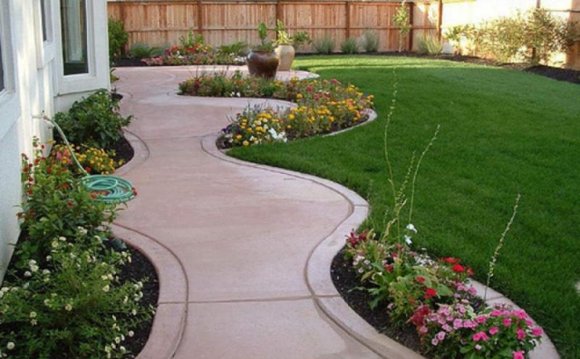
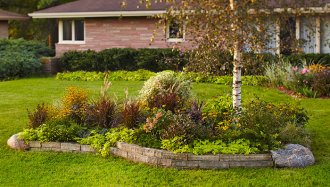 Trees play an important role in the home landscape. In addition to providing shade and ambience, they fill a critical design need: Trees are the only plant large enough to work with the scale of a house.
Trees play an important role in the home landscape. In addition to providing shade and ambience, they fill a critical design need: Trees are the only plant large enough to work with the scale of a house.
By itself, this birch tree would make a fine addition to the front yard. But when placed in an island bed with other plants, it feels more at home visually. Instead of an odd-looking exclamation point in the middle of the lawn, it’s integrated with the overall landscape.
Raised on just one side to tame the slope of the yard, the bed’s stonework creates a handsome stage for plants. To counter the geometric lines of the house and hedge, the bed has an organic shape and is decorated with randomly spaced boulders. It’s also asymmetrical, placed so the tree is off-center.
Good to Know: It’s best to create an island bed at the same time you’re planting so you can place the tree’s root ball at the proper level after grade changes are made. If creating an island bed around an existing tree, avoid smothering tree roots. Add no more than 2 inches of soil beneath the canopy and keep soil away from the trunk.
The garden bed features a range of plant heights for a more natural look. After all, nature doesn’t go from diminutive groundcover to tall tree without something in between. In this case, the “in between” is handled by purple fountain grass, Russian sage, penstemon, and black-eyed Susan. Closer to the ground, trailing annuals and low-growing perennials and shrubs fill the blank spots.
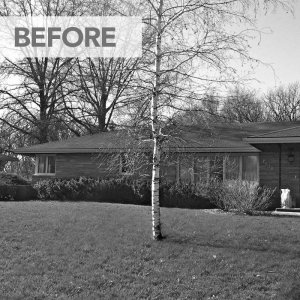 Two large terra-cotta pots fill the interior of the bed, eliminating the need to dig holes close to the trunk. The added height of the pots makes it possible to highlight seasonal plants such as phormium and sweet potato vine without breaking ground.
Two large terra-cotta pots fill the interior of the bed, eliminating the need to dig holes close to the trunk. The added height of the pots makes it possible to highlight seasonal plants such as phormium and sweet potato vine without breaking ground.
Good to Know: The majority of a tree’s roots are in the top 18 inches of soil. When planting beneath a tree, start with modest-size specimens that require smaller planting holes. Trailing groundcovers are a good option because you dig only a few holes, then let the plants spread over the remaining ground.
For continuity, two colors are repeated: chartreuse and burgundy. Here, a chartreuse sweet potato vine contrasts with a burgundy weigela. The sweet potato vine’s bright color echoes throughout the bed and in the background beneath a yew hedge. Burgundy is also prominent, showing up in purple fountain grass, ninebark, weigela, phormium, and ajuga.
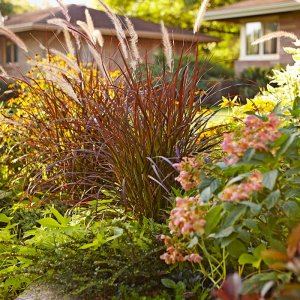 The blooms of black-eyed Susan (Rudbeckia fulgida) are bright, numerous, and long-lasting. Individual blooms last for weeks. And if you remove faded flowers, the floral show will go another month or more.
The blooms of black-eyed Susan (Rudbeckia fulgida) are bright, numerous, and long-lasting. Individual blooms last for weeks. And if you remove faded flowers, the floral show will go another month or more.
Another rudbeckia, Gloriosa daisy, is an inexpensive source of enduring color. This self-seeding perennial will return year after year even though the parent plant lasts just a year or two.
Good to Know: Because the canopy is narrow and lower branches are absent, a good deal of sunlight penetrates to the bed. That means you can grow a wider selection of plants, including sun-loving species that appreciate a few hours of shade in the afternoon.
Along with flowers, foliage can also inject brightness into a garden. This variegated ‘French Lace’ weigela looks attractive whether it’s flowering or not. Peak bloom is early summer, but this repeat bloomer manages to produce a second round of flowers in late summer.
Another source of season-long color is variegated dogwood. Located on the western side of the tree where it gets afternoon protection from the sun, it can be kept trimmed to about 4 feet in height.
Plant List
- Sweet potato vine (Ipomoea batatas ‘Marguerite’), annual
- Dwarf purple ninebark (Physocarpus opulifolius Tiny Wine), Zones 2–7
- Black-eyed Susan (Rudbeckia fulgida), Zones 4–9
- Purple ninebark (Physocarpus opulifolius Diabolo), Zones 2–7
- Moonbeam coreopsis (Coreopsis verticillata ‘Moonbeam’), Zones 4–8
- Creeping juniper (Juniperus horizontalis ‘Bar Harbor’), Zones 3–9
- Purple fountain grass (Pennisetum setaceum ‘Purpureum’), Zones 8–11 or annual
- Variegated dogwood (Cornus alba), Zones 2–8
- Prostrate rock cotoneaster (Cotoneaster horizontalis ‘Perpusillus’), Zones 4–7
- Creeping phlox (Phlox subulata), Zones 3–8
- Panicle hydrangea (Hydrangea paniculata), Zones 4–8
- Potted cordyline and ‘Blackie’ sweet potato vine, both annuals
- Wine & Roses weigela (Weigela florida ‘Alexandra’), Zones 5–8
- Ajuga (Ajuga ‘Chocolate Chip’), Zones 4–9
- Gloriosa daisy (Rudbeckia hirta ‘Prairie Sun’), Zones 5–8 or annual
- Potted phormium and ‘Marguerite’ sweet potato vine, both annuals
- Variegated weigela (Weigela florida ‘French Lace’), Zones 5–8
- Japanese silver grass (Miscanthus sinensis ‘Variegatus’), Zones 5–9
- Penstemon (Penstemon digitalis ‘Husker Red’), Zones 3–8
